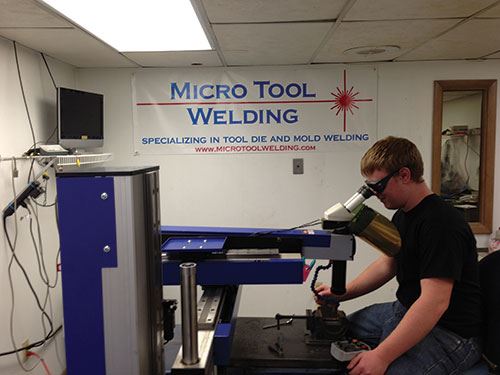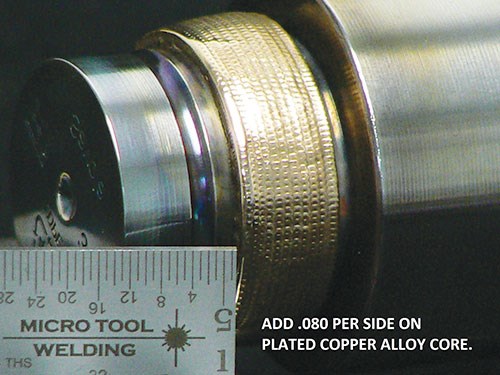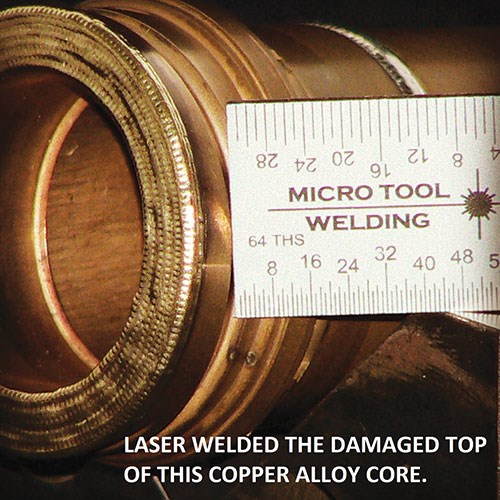Business Booms with Advanced Micro-Laser Welding Capabilities
Micro Tool Welding combines the science of laser technology with experience in tool and die repair.
Scott Mesick has been micro-TIG (tungsten inert gas) welding for the moldmaking industry since 1980. He launched Erie, Pennsylvania-based Micro Tool Welding (MTW) in 2003 and has since led the company in its tool and die welding specialization.
MTW is strategically located about equal distances from Cleveland, Pittsburgh and Buffalo, which enables the company to quickly serve its tool and die, medical, aerospace and power generation customers across the country. The 4,400-square-foot facility has a temperature-controlled environment that includes micro-TIG and micro-laser welding labs. “Our experience and knowledge combined with the latest technology has allowed us to become leaders in the micro-welding industry,” Mesick says. “We have combined the advanced science of laser technology with the experience in tool and die repair.”
Laser-focused on Quality and Speed
MTW faced several challenges after it was established, including reaching into areas that cannot be reached by micro-TIG welding, being able to apply small weld deposits on aluminum and copper alloys, and keeping the heat-affect zone (sink) to a minimum. Adding micro-laser welding to the company’s capabilities would help address these challenges. And since MTW is known for its quick turnaround times—often same-day—Mesick wanted to add more laser capabilities to serve his customers even faster.
Mesick visited several laser welder manufacturers before making his final purchasing decision. “After reading a 2007 case study in MoldMaking Technology on O.R. Laser USA, a laser welder manufacturer based in Elk Grove Village, Illinois, I knew its system would best suit my applications.” He immediately flew to Chicago to visit the company.
“I took a part with me that was almost impossible to micro-TIG weld and gave it to the technician,” Mesick recalls. “With no hesitation he took the part and welded it. I was totally amazed. That is what sold me. It was a super-small insert from a mold that you had to pick up with tweezers. He had to weld in a hole in between two standing legs sticking up on the part, and he had to reach down in this hole. I was totally baffled at how he could do that—and it took him about 10 minutes.”
Mesick purchased a 200-watt laser welder in 2007 from O.R. Laser. He also added a 300-watt laser welder in 2010 so he could weld copper and aluminum alloys more easily. These machines have been instrumental in helping MTW become a leader in micro-laser welding.
Due to the increased volume of work the company realized after the purchase of the 200-watt welder—and the quality, performance and customer service O.R. Laser provided—MTW has since purchased two more laser welders.
“Using the most advanced laser welders has allowed us to achieve minimal to undetectable weld sink and distortion,” Mesick says. “And the laser movement is mechanical, making it capable of providing a straight and consistent weld bead profile.” Additionally, Mesick notes that these machines offer the ability to weld close to standing features without damage to surrounding areas; and the laser technician is able to deposit weld uniformly and accurately.
And when it comes to necessary machine service, O.R. Laser quickly responds, Mesick maintains: “Like anything you own, there comes a day when some kind of service is needed. O.R. does whatever it can to service the machines. If I have trouble and an O.R. technician is available, he will drive or fly to Erie to fix the machine. I tell him what is wrong, and he has a general idea of what it could be. This knowledge enables him to narrow down the problem and select the appropriate part to bring with him. Then when he diagnoses the problem on site, he has the parts on hand to fix it.”
Laser-focused on the Future
Business has exploded since Mesick added the 300-watt machine, and his experience with micro-TIG welding helped him pick up the new technology quickly and impart that knowledge onto his employees.
“I was already working under a microscope, and the wire that I am using is the same wire,” he explains. “The only thing that is different is the application: laser light vs. electrode electricity. It has been easy for me to pass this knowledge onto my team. The average learning curve is typically less than an hour. If you are experienced, you can pick it up even quicker. It all depends on the individual. There are crosshairs when you look through the lens and you can pinpoint the area that needs to be welded, and you just lay the wire right down by the crosshairs and hit the foot control.” And because the machine is portable, it can be rolled right up to the part, if necessary.
The faster laser machine allows MTW to turn work around quicker without sacrificing quality. “Quality is number one to my customers,” Mesick says. “Speed is their number two concern, and price is third. This machine is high-quality.”
According to Mesick, MTW’s work speaks for itself, and the fact that 90 percent of the work comes from out of town is proof. Mesick plans on adding another employee in the near future as well as another machine, once the economy is more stable. “It is a big purchase, but a definite one. O.R. Laser’s equipment has enabled my business to expand and stay competitive.”
For more information:
O.R. Laser USA
847-593-5711
or-laser.com
Micro Tool Welding
814-833-1711
microtoolwelding.com
Related Content
Considerations for Mold Base Material Selection
Choosing the right material can greatly affect the profitability and cost of your application.
Read MoreFundamentals of Designing the Optimal Cooling System
The right mold components can help improve mold cooling and thereby produce higher-quality parts.
Read MoreThe Benefits of Hand Scraping
Accuracy and flatness are two benefits of hand scraping that help improve machine loop stiffness, workpiece surface finish and component geometry.
Read MoreAdvantages and Disadvantages of Copper and Graphite Electrodes
Both copper and graphite provide approximately the same end result, so it is important for a shop to consider the advantages and disadvantages of each material in order to discover what would work best in their shop floor environment.
Read MoreRead Next
Are You a Moldmaker Considering 3D Printing? Consider the 3D Printing Workshop at NPE2024
Presentations will cover 3D printing for mold tooling, material innovation, product development, bridge production and full-scale, high-volume additive manufacturing.
Read MoreHow to Use Strategic Planning Tools, Data to Manage the Human Side of Business
Q&A with Marion Wells, MMT EAB member and founder of Human Asset Management.
Read More











.jpg;maxWidth=300;quality=90)

















